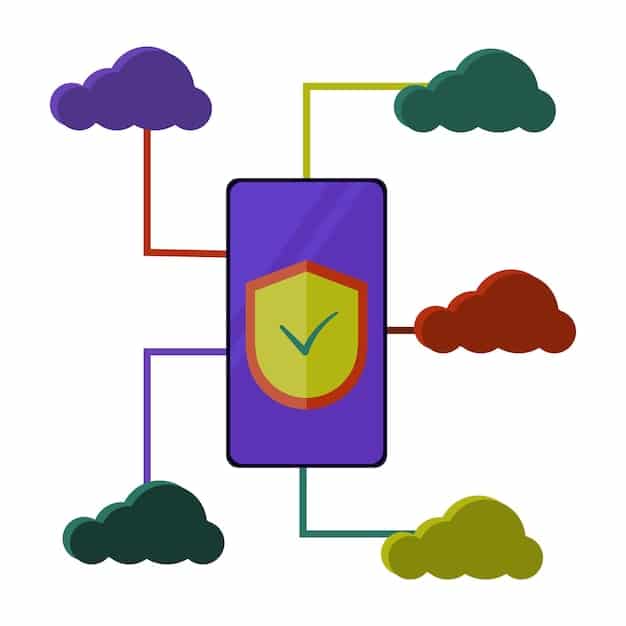Cloud Security Best Practices: Data Protection Guide for 2025

Cloud security best practices in 2025 revolve around implementing a multi-layered approach, including strong encryption, access management, regular audits, and proactive threat detection to safeguard data and maintain compliance in an evolving digital landscape.
Navigating the complexities of cloud security can seem daunting, but implementing the right **cloud security best practices** is crucial to protect your valuable data from ever-evolving cyber threats.
Understanding the Cloud Security Landscape
The cloud has revolutionized how businesses operate, offering scalability, flexibility, and cost-efficiency. However, this digital transformation also introduces new security challenges. It’s vital to understand the cloud security landscape to implement effective protective measures.
Shared Responsibility Model
Cloud security operates on a shared responsibility model, where the cloud provider secures the infrastructure and the customer is responsible for securing data and applications. Understanding this division of labor is crucial.
Organizations must take ownership of their data security and access management within the cloud environment.
Evolving Threat Landscape
Cyber threats are constantly evolving, with new attack vectors targeting cloud environments. Staying informed about the latest threats is essential for proactive protection.
- Ransomware attacks targeting cloud-stored data.
- Data breaches resulting from misconfigured cloud settings.
- Insider threats leading to unauthorized access and data leakage.
The cloud security landscape is complex and ever-changing, requiring ongoing vigilance and adaptation.

Implementing Strong Access Management
Effective access management is a cornerstone of cloud security. Restricting access to sensitive data and applications based on the principle of least privilege minimizes the risk of unauthorized access and data breaches.
Multi-Factor Authentication (MFA)
MFA adds an extra layer of security by requiring users to provide multiple forms of identification, such as a password and a one-time code sent to their mobile device. This significantly reduces the risk of unauthorized access.
Enforcing MFA for all users, especially those with privileged access, is a critical security measure.
Role-Based Access Control (RBAC)
RBAC assigns permissions based on a user’s role within the organization. This ensures that users only have access to the resources they need to perform their job duties, minimizing the potential for misuse or accidental data exposure.
- Defining clear roles and responsibilities within the organization.
- Granting permissions based on the principle of least privilege.
- Regularly reviewing and updating user access rights.
Implementing strong access management controls strengthens your cloud security posture and protects sensitive data.
Data Encryption: Protecting Data at Rest and in Transit
Data encryption is the process of converting data into an unreadable format, rendering it useless to unauthorized individuals. Encrypting data both at rest and in transit is crucial for protecting sensitive information in the cloud.
Encryption at Rest
Encrypting data at rest ensures that even if a storage device is compromised, the data remains protected. Many cloud providers offer built-in encryption options for storage services.
Implementing encryption at rest is a fundamental step in safeguarding data from unauthorized access.
Encryption in Transit
Encrypting data in transit protects it from interception during transmission between systems. Using protocols like HTTPS and TLS ensures that data is encrypted while being transferred over the network.
Enabling encryption in transit protects data from eavesdropping and tampering during network communication.

Regular Security Audits and Assessments
Regular security audits and assessments are essential for identifying vulnerabilities and ensuring that security controls are effective. These audits should cover various aspects of cloud security, including access management, data encryption, and network security.
Vulnerability Scanning
Vulnerability scanning tools can automatically identify known vulnerabilities in cloud systems and applications. Regularly scanning for vulnerabilities allows organizations to proactively address potential security weaknesses.
Automated vulnerability scanning helps identify and remediate potential security flaws before they can be exploited.
Penetration Testing
Penetration testing involves simulating real-world attacks to identify weaknesses in security controls. Skilled penetration testers can uncover vulnerabilities that automated tools may miss.
- Simulating real-world attack scenarios.
- Identifying weaknesses in security controls.
- Providing recommendations for remediation.
Regular security audits and assessments help organizations maintain a strong cloud security posture and mitigate potential risks.
Incident Response and Disaster Recovery
Even with the best security measures in place, incidents can still occur. Having a well-defined incident response plan and a robust disaster recovery strategy is essential for minimizing the impact of security events.
Incident Response Plan
An incident response plan outlines the steps to be taken in the event of a security incident, including identifying, containing, and recovering from the incident. A well-defined plan helps organizations respond quickly and effectively to security breaches.
A comprehensive incident response plan enables organizations to react swiftly and minimize the damage from security incidents.
Disaster Recovery Strategy
A disaster recovery strategy ensures that critical business functions can be restored quickly in the event of a disaster, such as a natural disaster or a major security breach. This may involve replicating data to geographically diverse locations and implementing failover mechanisms.
- Creating backup and recovery procedures.
- Testing the disaster recovery plan regularly.
- Ensuring data replication to multiple locations.
Staying Compliant with Cloud Security Regulations
Many industries are subject to specific regulations pertaining to data security and privacy. Organizations must ensure that their cloud security practices comply with all applicable regulations, such as HIPAA, GDPR, and PCI DSS.
Data Residency Requirements
Some regulations require that data be stored within specific geographic regions. Organizations must carefully consider data residency requirements when choosing a cloud provider and configuring their cloud services.
Adhering to data residency requirements ensures compliance with regional data protection laws.
Compliance Certifications
Cloud providers often obtain certifications that demonstrate their compliance with industry standards and regulations. Choosing a cloud provider with relevant certifications can simplify the compliance process.
- Ensuring compliance with relevant regulations (HIPAA, GDPR, PCI DSS).
- Selecting a cloud provider with appropriate compliance certifications.
- Conducting regular compliance audits.
Staying compliant with cloud security regulations is essential for maintaining trust and avoiding penalties.
| Key Aspect | Brief Description |
|---|---|
| 🛡️ Access Management | Implement MFA and RBAC to restrict unauthorized access to sensitive data. |
| 🔒 Data Encryption | Encrypt data at rest and in transit to protect against interception and unauthorized access. |
| 🔎 Regular Audits | Perform vulnerability scans and penetration testing to identify and address security gaps. |
| 🚨 Incident Response | Prepare a plan for swift incident response and data recovery. |
Frequently Asked Questions
▼
The shared responsibility model defines the security obligations between the cloud provider and the customer. The provider secures the infrastructure, while the customer is responsible for securing data and applications stored in the cloud.
▼
MFA adds an extra layer of security by requiring users to provide multiple forms of identification before granting access. This makes it more difficult for attackers to gain unauthorized access to cloud resources.
▼
Data encryption converts data into an unreadable format, rendering it useless to unauthorized individuals. Encrypting data both at rest and in transit protects it from interception and unauthorized access.
▼
Regular security audits and assessments help identify vulnerabilities and ensure that security controls are effective. This allows organizations to proactively address potential security weaknesses and maintain a strong cloud security posture.
▼
Organizations can ensure compliance with cloud security regulations by understanding data residency requirements, selecting a cloud provider with appropriate compliance certifications, and conducting regular compliance audits.
Conclusion
In conclusion, implementing robust cloud security best practices is essential for protecting your data in the cloud. By understanding the shared responsibility model, implementing strong access management, encrypting your data, conducting regular audits, and staying compliant with regulations, you can significantly reduce your risk of security breaches and maintain a secure cloud environment.





